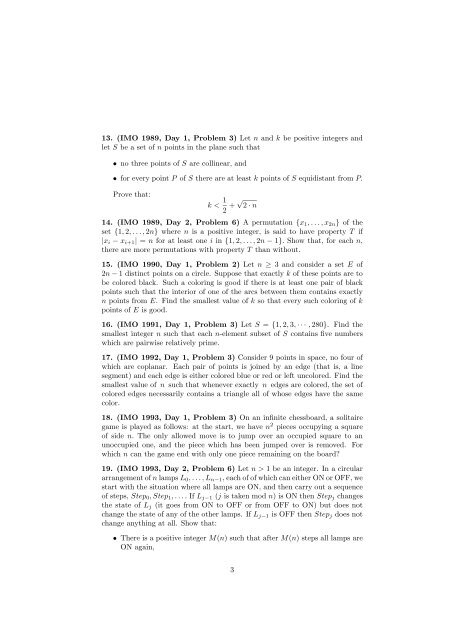Combinatorics Problems
Combinatorics Problems
Combinatorics Problems
You also want an ePaper? Increase the reach of your titles
YUMPU automatically turns print PDFs into web optimized ePapers that Google loves.
13. (IMO 1989, Day 1, Problem 3) Let n and k be positive integers and<br />
let S be a set of n points in the plane such that<br />
• no three points of S are collinear, and<br />
• for every point P of S there are at least k points of S equidistant from P.<br />
Prove that:<br />
k < 1 2 + √ 2 · n<br />
14. (IMO 1989, Day 2, Problem 6) A permutation {x 1 , . . . , x 2n } of the<br />
set {1, 2, . . ., 2n} where n is a positive integer, is said to have property T if<br />
|x i − x i+1 | = n for at least one i in {1, 2, . . ., 2n − 1}. Show that, for each n,<br />
there are more permutations with property T than without.<br />
15. (IMO 1990, Day 1, Problem 2) Let n ≥ 3 and consider a set E of<br />
2n − 1 distinct points on a circle. Suppose that exactly k of these points are to<br />
be colored black. Such a coloring is good if there is at least one pair of black<br />
points such that the interior of one of the arcs between them contains exactly<br />
n points from E. Find the smallest value of k so that every such coloring of k<br />
points of E is good.<br />
16. (IMO 1991, Day 1, Problem 3) Let S = {1, 2, 3, · · · , 280}. Find the<br />
smallest integer n such that each n-element subset of S contains five numbers<br />
which are pairwise relatively prime.<br />
17. (IMO 1992, Day 1, Problem 3) Consider 9 points in space, no four of<br />
which are coplanar. Each pair of points is joined by an edge (that is, a line<br />
segment) and each edge is either colored blue or red or left uncolored. Find the<br />
smallest value of n such that whenever exactly n edges are colored, the set of<br />
colored edges necessarily contains a triangle all of whose edges have the same<br />
color.<br />
18. (IMO 1993, Day 1, Problem 3) On an infinite chessboard, a solitaire<br />
game is played as follows: at the start, we have n 2 pieces occupying a square<br />
of side n. The only allowed move is to jump over an occupied square to an<br />
unoccupied one, and the piece which has been jumped over is removed. For<br />
which n can the game end with only one piece remaining on the board?<br />
19. (IMO 1993, Day 2, Problem 6) Let n > 1 be an integer. In a circular<br />
arrangement of n lamps L 0 , . . .,L n−1 , each of of which can either ON or OFF, we<br />
start with the situation where all lamps are ON, and then carry out a sequence<br />
of steps, Step 0 , Step 1 , . . . . If L j−1 (j is taken mod n) is ON then Step j changes<br />
the state of L j (it goes from ON to OFF or from OFF to ON) but does not<br />
change the state of any of the other lamps. If L j−1 is OFF then Step j does not<br />
change anything at all. Show that:<br />
• There is a positive integer M(n) such that after M(n) steps all lamps are<br />
ON again,<br />
3
















